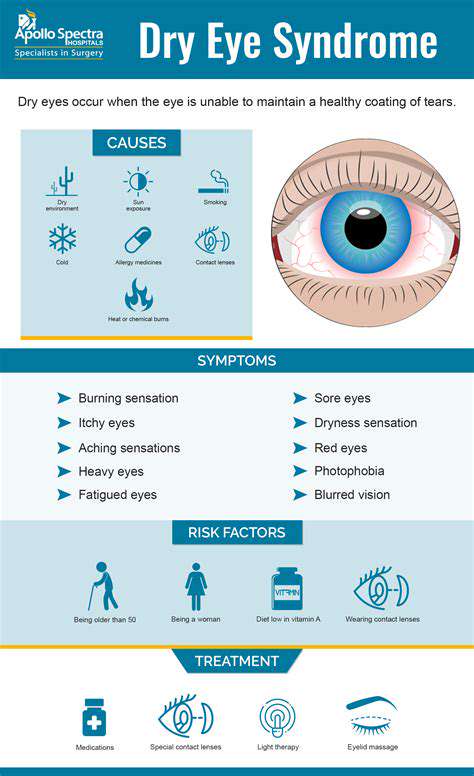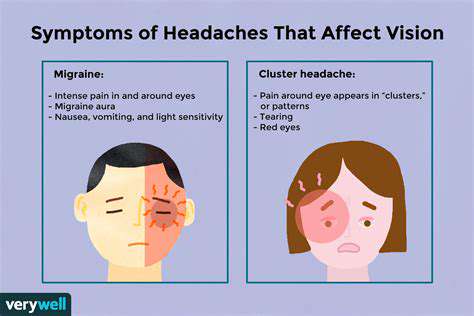- Persistent eye fatigue
- Intermittent blurred vision
- Recurrent head pain
- Episodes of double vision
Symptom severity fluctuates with activity levels and environmental conditions. Many sufferers dismiss early warning signs, allowing problems to progress. Documenting symptom frequency, triggers, and pain characteristics assists healthcare providers in making accurate assessments.
The Eye Strain-Headache Cycle
Prolonged focus during reading, screen time, or detailed work strains ocular muscles. Existing muscle imbalances magnify this strain exponentially, creating tension that radiates through the head. The nervous system interprets this sustained muscle activity as pain signals, establishing a vicious cycle of discomfort.
While ergonomic adjustments and regular breaks provide temporary relief, addressing underlying muscle dysfunction through targeted therapies offers lasting solutions. Specialized treatments can break this physiological feedback loop at its source.
Diagnostic Approaches and Therapeutic Solutions
Comprehensive evaluations assess:
- Visual acuity measurements
- Ocular motility testing
- Binocular vision analysis
- Neurological assessments
Treatment modalities range from non-invasive vision therapy to surgical corrections. Customized eye exercises can rebuild muscular coordination, while prism lenses may compensate for alignment issues. Early intervention maximizes treatment success rates and minimizes lifestyle disruptions.
Proactive Prevention Strategies
Effective prevention incorporates:
- Scheduled visual breaks (20-20-20 rule)
- Optimal workspace lighting
- Prescription eyewear compliance
- Annual comprehensive eye exams
Feng Shui, the ancient Chinese environmental harmony practice, offers complementary approaches to workspace optimization that may reduce visual stressors. The system's focus on balanced energy (Qi) flow aligns with modern ergonomic principles for eye health.
Dry Eye Syndrome and its Impact on Headaches

Understanding Dry Eye Pathology
Dry eye syndrome involves either inadequate tear production or poor tear quality. This multifactorial condition stems from diverse causes including aging processes, medication side effects, environmental conditions, and systemic health issues. Recognizing these contributing factors enables targeted treatment approaches.
Symptom presentation varies considerably but often includes:
- Burning or stinging sensations
- Foreign body sensation (grittiness)
- Paradoxical excessive tearing
- Light sensitivity
Environmental exacerbators like wind or smoke dramatically intensify discomfort, creating conditions ripe for headache development as the body attempts to compensate for ocular irritation.
Quality of Life Implications
Chronic dry eye disrupts:
- Professional productivity
- Leisure activities
- Social interactions
- Sleep quality
The condition's ripple effects extend far beyond physical discomfort, potentially triggering anxiety or depression in severe cases. Many sufferers unconsciously limit activities to avoid symptom flare-ups, creating self-imposed lifestyle restrictions that further diminish wellbeing.
Comprehensive Management Approaches
Effective treatment plans incorporate:
- Artificial tear supplements
- Prescription anti-inflammatory drops
- Environmental modifications
- Nutritional support (omega-3s)
- Punctal occlusion procedures
Consistent preventive care proves more effective than reactive symptom management. Humidification systems, protective eyewear, and blink exercises form the foundation of sustainable dry eye management. Regular ophthalmologic evaluations help adjust treatments as conditions evolve.
Other Vision-Related Headache Triggers

Expanding the Diagnostic Framework
Vision-triggered headaches present with diverse characteristics from dull pressure to throbbing pain. These symptoms frequently indicate underlying visual system dysfunction requiring professional evaluation. Ignoring such warnings may allow correctable conditions to progress unnecessarily.
The Digital Eye Strain Epidemic
Modern lifestyles contribute to:
- Increased near-work demands
- Prolonged screen exposure
- Reduced blink rates
- Poor viewing ergonomics
These factors combine to overload the eyes' focusing mechanisms, creating muscular tension that frequently manifests as headaches. Strategic work breaks, proper monitor positioning, and specialized computer glasses can help mitigate these effects.
Refractive Error Complications
Uncorrected vision problems force the eyes to work harder, creating:
- Ciliary muscle fatigue
- Compensatory head tilting
- Squinting-induced tension
Regular comprehensive eye exams remain the best defense against headache-inducing refractive errors. Updated prescriptions and specialized lens coatings can dramatically reduce these preventable triggers.
Integrated Management Philosophy
Successful treatment requires:
- Accurate diagnosis
- Multimodal therapy
- Patient education
- Long-term monitoring
Collaboration between eye care professionals and headache specialists yields the best outcomes for complex cases. Emerging technologies like blue light filtering and vision therapy apps provide new tools for managing these interconnected conditions.